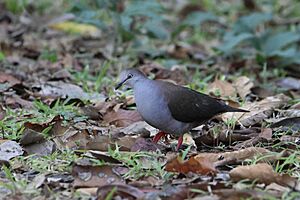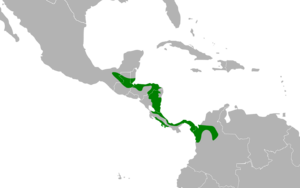Grey-chested dove facts for kids
Quick facts for kids Grey-chested dove |
|
|---|---|
 |
|
| Conservation status | |
| Scientific classification | |
| Genus: |
Leptotila
|
| Species: |
cassinii
|
 |
|
| Synonyms | |
|
Leptotila cassini |
|
The grey-chested dove (Leptotila cassinii) is a type of bird in the Columbidae family, which includes doves and pigeons. You can find this bird in several countries in Central and South America. These include Belize, Colombia, Costa Rica, Guatemala, Honduras, Mexico, Nicaragua, and Panama.
Contents
About This Dove
The grey-chested dove is related to other doves like the Tolima dove and the ochre-bellied dove. Scientists sometimes group these birds together because they are so similar. There are three slightly different kinds, or subspecies, of the grey-chested dove. These are called L. c. cassinii, L. c. cerviniventris, and L. c. rufinucha.
What It Looks Like
The grey-chested dove is about 22.5 to 28 centimeters (9 to 11 inches) long. It weighs between 132 and 179 grams (4.7 to 6.3 ounces).
Let's look at the most common type, L. c. cassinii:
- Its forehead and face are a soft pinkish-gray.
- The top of its head and the back of its neck are dark brown.
- The back of its neck also has shiny, iridescent colors like grayish-purple.
- Its upper body is olive-brown, with shimmery green or purple on its shoulders.
- The tail is darker than its back, and the outer tail feathers have white tips.
- Its throat is white, and its chest is reddish-gray.
- The belly is a reddish color.
- Its eyes are yellow, surrounded by bare gray skin that looks reddish near the front and back.
- Its legs and feet are red.
Both male and female grey-chested doves look very much alike. However, females are usually a bit darker overall. The other subspecies have slight color differences, like paler feathers or a more purplish-pink chest.
Where It Lives
The different types of grey-chested doves live in specific areas:
- The L. c. cassinii subspecies lives from Panama's Canal Zone into northern Colombia.
- L. c. cerviniventris is found from southeastern Mexico (in a place called Chiapas) south through Belize, Honduras, Nicaragua, and northwestern Costa Rica, reaching into western Panama.
- L. c. rufinucha lives in southwestern Costa Rica and northwestern Panama.
These doves prefer to live in secondary forest. This means forests that have grown back after being cut down. They can be found from sea level up to about 1,400 meters (4,600 feet) high. In some parts of Costa Rica, they are only found up to 750 meters (2,460 feet) high.
Behavior
Feeding Habits
The grey-chested dove looks for food on the ground. It usually forages alone or with just one other dove. They do not gather in large groups or flocks. While we don't know everything about what they eat, they have been seen eating seeds and small insects.
Reproduction and Nests
The time of year when grey-chested doves lay eggs changes depending on where they live.
- In Costa Rica, they have two breeding seasons: one from February to May and another from July to September.
- In Panama, they breed between February and September.
- In Colombia, it seems they breed from January to April.
They build a simple, shallow nest using twigs and straw. These nests are usually placed on a tree branch or hidden in a thick bush or tangled vines. They build their nests about 1 to 5 meters (3 to 16 feet) above the ground. A female dove typically lays two eggs at a time.
Vocalization
The song of the grey-chested dove is quite unique. It's described as a "mournful monotonous note." It sounds like a long "woOOOooo" sound that quickly gets quieter and then slowly fades away.
Conservation Status
The IUCN (International Union for Conservation of Nature) has listed the grey-chested dove as a species of "Least Concern." This means that even though we don't know every detail about their lives, they are considered to be fairly common in most places where they live. Their population is not currently in danger.


